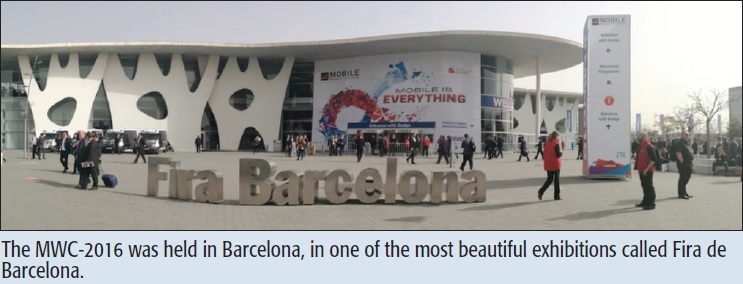
As everyone knows, the Mobile World Congress (MWC) is the world’s biggest and most influential mobile event. This year the conference was held February 22–25 in Barcelona (Spain). This edition of MWC was the 10th time that it has been held in Barcelona. Until 2005 the Congress was held in Cannes (France) under the name of 3GSM World. In 2006 it was moved to Barcelona and since then it has become one of the biggest technology events. This relationship will continue until at least 2023, thanks to the agreement that was reached recently.
The event consists of three main blocks. The first block is the conferences, all related to mobile technologies; the second is the exhibition zone, where companies show their novelties; the third block consists of a dozen parallel events. The presence of up to 95,000 attendees and approximately 2,000 companies that have participated in the exhibition zone are both clear indicators of the success of MWC-16.
MWC is mainly focused on mobile devices. In past years, there have been huge announcements of devices at MWC. However, this year MWC was also focused on other issues, like vehicular technology, new mobile payment methods, new trends in ISP (Internet service providers) mobile products and services, and finally virtual reality, whose scale of presence was the biggest surprise. The most relevant companies in the cellular market showed their new mobile designs that incorporate a virtual reality (VR) headset. The image of conference attendees looking in all directions with their virtual reality headsets has become the snapshot that best summarizes MWC-16. Now it is time to see if the applications supporting this new technology actually attract consumers.
On the other hand, the new mobile payment services and related technologies presented at MWC-16 also attracted great attention. One of the most promising was the Paypal Here reader, based on NFC (near field communication) technology. This reader is able to understand any type of payment method. In the same business line, another important novelty was the mobile banking service called imaginBank, presented by La Caixa. With imaginBank, you can do what you usually do in a traditional bank, but also much more, thanks to the inherent benefits of IT technologies. In imaginBank, all the banking services are online; the users manage their own financial resources by themselves, with the help of a set mobile app and social networks. The final touch was led by MasterCard, who presented an authentication technology based on selfies called selfie-pay. This app enables consumers to validate their transactions with a simple selfie. It is clear that all these pieces must be put to work together in order to provide value added on-line banking and shopping services to the community.

Regarding mobile devices, the most relevant premiere was a modular phone design that lets you attach accessories directly to it. The device can be prepared in any way the consumer likes it. Another interesting issue was the internal water circuits to keep the processor cool, keeping it from overheating. However, it remains to be seen if consumers continue to opt for highend devices, or as recently noted in data sales, these types of high-performance mobile devices are passed over in favor of an increasingly compelling midrange in features and prices.
The next generation of mobile communications (5G) was on many MWC-16 minds. The focus on 5G has been all about connecting things to the Internet, when in fact much of the world does not even have access to the basics. Facebook Chief Executive Mark Zuckerberg pointed out that while a small section of the connected world is racing to embrace next-generation technology, the majority of people, including large swaths of Europe and the USA, are still using 2G, a technology that is 25 years old. Zuckerberg cautioned that the gap between the small wealthy majority and everyone else is only going to widen if we keep going the way we are.
Finally, another remarkable event at MWC-16 was the Mobile Premier Awards (MPA). The MPA is an organization that was born in Barcelona, and it is completely independent of MWC. However, this year they presented the award at MWC-16. It is an acknowledgement of the best app developed by startup companies around the world. There were 16 apps competing for the award (http://mobilepremierawards.com/finalists-2016), which in the end was won by Jordi Llonch, CEO and founder of Sharing Academy, S.L. The application puts in students in contact with senior students, who act as teachers. The app was born out of Jordi’s personal experience, and it receives approximately 6,000 visits every day.
It can be concluded that the most recent edition of Barcelona MWC did not strictly follow the tradition of focusing on mobile devices. On the contrary, it expanded to other very prominent fields of the mobile world. In this way, Barcelona MWC has definitely become the principal reference of the mobile technology.